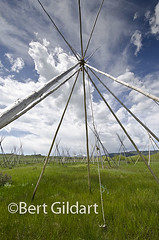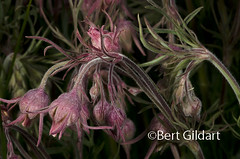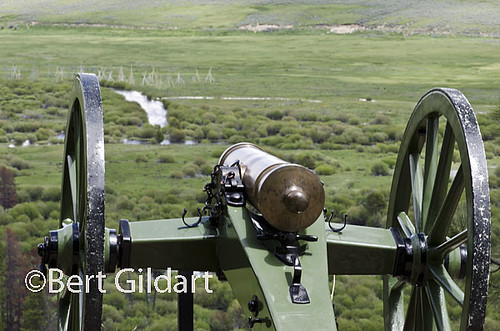In a Field Where Camas Grows
©Bert Gildart: In a flowering field of camas, prairie smoke and bistort, tipi poles stand today like skeletons all reminiscent now of a great tragedy – of a particularly ugly time in America’s history.

Camas now grows in a meadow where Nez Perce Indians once camped, attempting to maintain their freedom; symbolized by tipi poles.
The skeletons remind the sympathetic that on an August morning in 1887, before the sun had even risen, approximately 170 soldiers, led by Colonel John Gibbon, fired into a sleeping camp of approximately 800 Nez Perce Indians. About two thirds of the group were women and children and the only crime they had committed was that they did not want to be forced onto a reservation in Idaho.
BROKEN TREATY
They believed that the treaty of 1863 with the American government, guaranteeing the tribe that the land known as the Wallowa would forever be theirs. Settlers, however, discovered gold in the Walla Walla Valley and the Nez Perce were ordered onto the Lapwai Reservation.
Camas closeup, tipi poles, prairie smoke — all stand in a field where a band of Nez Perce Indians fled from soliders. The Nez Perce hoped to retain freedom and not be forced onto a reservation. They had been guaranteed the right to remain in their homeland by a treaty of 1863 — but settlers discovered gold.
Many went, but five bands of Non-Treaty Nez Perce refused, and when hostilities broke out in Idaho near the reservation, the five bands were forced to flee. Leaders such as Chief Joseph and Chief Looking Glass hoped that once they reached Montana they would be safe. They thought they might find a home with the Crow People and so they embarked on a great journey. And now they were in western Montana, believing themselves to be relatively safe. Here, along the meandering North Fork of the Big Hole River, all sandwiched between the Beaverhead, Pintlar and Pioneer mountains, they cut lodge poles and erected their tipis (also correct tepee). They hunted and dug the bulbs of camas and bistort, favorite foods they knew from previous hunting excursions to be abundant along the North Fork. Though they posted sentries, the Nez Perce believed the pursuing Army troops were far behind.
MISDIRECTED FORCE
Today, as we walk along the peacefully meandering river, the site of misdirected forces, we read the words of Yellow Wolf from a Park Service brochure. Yellow Wolf said he returned after the onslaught and began his search for survivors, looking in a maternity lodge that had been occupied by a pregnant woman. The tipi was silent and inside Yellow Wolf found the woman lying dead in her blankets. In her arms she held her newborn baby, its head smashed by a gun breech or by the heel of a boot.
Immediately after the initial attack the Nez Perce desperately sought cover, running into willow thickets, even submerging themselves in the river, but Chief White Bird’s voice carried over the screams of horror, rifle fire and even canon fire. “Why are we retreating,” he shouted.
And so began an incredible turn about. Before long, soldiers fell and soon the tide began to turn on what was to have been a slaughter; and as we walked the fields, our hopes and cheers went out for the Nez Perce. Brave warriors had turned the tide, but unfortunately the tribe had to flee once again, for they knew reinforcements might soon join Colonel Gibbon.
The plight of the Nez Perce is one of the greatest stories of the human spirit for freedom, and later this summer, Janie and I will again meet the tribe. In fact, we plan to meet them twice as our travels will take us through the state, for we are fortunate to have yet another book to work on. As we gather material for our Montana book, we’ll also be covering many other aspects of this state which I began calling home back in the ‘60s. But the plight of the Nez Perce has always been a subject of great interest, and as we walked the fields of camas, bistort, prairie smoke and all the other features of enduring beauty, its story of pathos continues to stand in stark contrast with the grandeur of this great state.
——————————
THIS TIME TWO YEARS AGO:
*Airstream Helps Many Age Gracefully
ADDS FROM GOOGLE AND AMAZON AUGMENT OUR TRAVELS:





